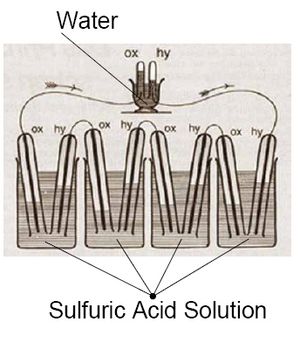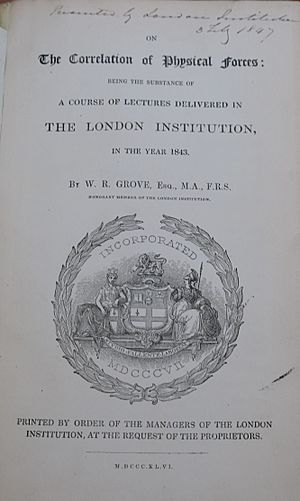William Robert Grove facts for kids
Quick facts for kids
Sir William Robert Grove
|
|
|---|---|

William Robert Grove
|
|
| Born | 11 July 1811 Swansea, Wales
|
| Died | 1 August 1896 (aged 85) London
|
| Nationality | Welsh |
| Alma mater | Brasenose College, Oxford |
| Known for | conservation of energy, invention of fuel cell, defending William Palmer |
| Awards | Royal Medal (1847) |
| Scientific career | |
| Fields | physics, chemistry, patent law, criminal law, |
| Institutions | Lincoln's Inn British judiciary Royal Institution Royal Society Privy council |
Sir William Robert Grove (born July 11, 1811 – died August 1, 1896) was a brilliant Welsh scientist and judge. He was a very important person in the history of science. He helped us understand how energy works and invented the first fuel cell. He also created a special type of battery called the Grove voltaic cell.
Contents
Early Life and Education
William Robert Grove was born in Swansea, Wales. He was the only child of John and Anne Grove. His father was a local official.
William learned from private teachers when he was young. Later, he went to Brasenose College, Oxford University. There, he studied classics, which means ancient Greek and Roman history and languages. He also became very interested in science. He finished his studies in 1832.
In 1835, William became a lawyer. He joined the Royal Institution in the same year. This was a famous place for science. He also helped start the Swansea Literary and Philosophical Society. He stayed connected with this group for a long time.
Amazing Scientific Discoveries
In 1837, William Grove married Emma Maria Powles. They went on a trip to Europe for their honeymoon. This trip gave William time to work on his science ideas. He wrote his first scientific paper about new ways to build electric cells.
In 1839, Grove invented a new kind of electric cell. It was called the Grove cell. This cell used zinc and platinum metals in two different acids. These acids were kept separate by a special ceramic pot. He told scientists in Paris about his invention in 1839. In 1840, Grove also invented one of the first electric lights. This was before Thomas Edison made his famous light bulb.
Later that year, he shared his discoveries at a science meeting. Michael Faraday, a very famous scientist, was interested. Faraday invited Grove to talk about his work at the Royal Institution. This talk made Grove famous. Soon, he became a member of the Royal Society, a top science group.
Understanding Energy: The Correlation of Physical Forces
In 1841, Grove became a professor at the London Institution. In 1842, he gave a lecture where he talked about something very important. He called it the correlation of physical forces. Today, we call this the conservation of energy. This idea means that energy cannot be created or destroyed. It can only change from one form to another.
In 1842, Grove also created the first fuel cell. He called it the gas voltaic battery. This cell made electrical energy by mixing hydrogen and oxygen gases. He showed that steam (water vapor) could be split into hydrogen and oxygen. He also showed that this process could be reversed. This was the first time someone showed that molecules could be broken down into their basic atoms and then put back together.
Grove's work also helped scientists understand ionisation. He also discovered something called sputtering. This is a process where tiny particles are knocked off a surface by other particles.
In the 1840s, he worked on photography. He studied the Daguerreotype and calotype processes. He even predicted how important photography would become. He said it would help record history and facts forever.
In 1852, he found dark bands that appear during electrical breakdown. He studied these bands and shared his findings in 1858.
On the Correlation of Physical Forces Book
In 1846, Grove published his book, On The Correlation of Physical Forces. In this book, he shared his ideas about the conservation of energy. This was before another famous scientist, Hermann von Helmholtz, published his similar ideas.
Grove's ideas were very important for understanding energy. He thought that different forms of energy, like heat, light, and electricity, were all connected. He even wondered why the night sky is dark. He thought that light from distant stars might change into another form of motion as it travels through space. He believed that more forms of energy would be discovered in the future.
Legal Career and Judge Role
From 1846, William Grove started to focus more on his work as a lawyer. He needed to earn money for his growing family. In 1853, he became a Queen's Counsel, which is a senior lawyer. He often used his science knowledge in legal cases, especially in patent law. Patent law deals with inventions and who owns the rights to them.
He was involved in important photography patent cases. He also served on a special committee about patent law.
In 1871, he became a judge in the Court of Common Pleas. Later, in 1880, he moved to the Queen's Bench. He was known as a careful and fair judge. He was not afraid to have his own opinion. He retired from being a judge in 1887.
Family Life
William Grove and Emma Maria Powles had several children. One of his sons became Major-General Sir Coleridge Grove. His daughter, Imogen Emily, married William Edward Hall. Another daughter, Anna, married Herbert Augustus Hills.
William Grove was often troubled by his health. He passed away at his home in London on August 1, 1896, after a long illness. He is buried in Kensal Green Cemetery in London.
Honors and Legacy
William Grove received many honors for his work. He became a member of the Royal Society in 1840. In 1847, he received the Royal Medal, a very important award for science. He was also the Vice-President of the Royal Institution in 1844.
In 1872, he was given a knighthood, so he became "Sir" William Grove. He received an honorary degree from Cambridge University in 1879. In 1887, he became a Privy Councillor.
There is a lunar crater on the Moon named "Grove" in his honor. Also, a big meeting about fuel cells, called the Grove Fuel Cell Symposium, is named after him.
See also
 In Spanish: William Robert Grove para niños
In Spanish: William Robert Grove para niños
- Timeline of hydrogen technologies




